What is Skin Cancer?
Skin cancer refers to any cancer that starts in your skin. This can happen anywhere on your skin, including the palm of your hands, sole of your feet, and even your scalp. Skin cancer is also able to metastasize, spreading to nearby tissues and organs as the desease advances.
The two main types of skin cancer are:
- Non-Melanoma Skin Cancer: Also known as keratinocyte cancer, it develops in skin cells called keratinocytes. It has two main subtypes: Basal cell carcinoma (BCC) and squamous cell carcinoma (SCC).
- Malignant Melanoma: It develops in the cells that generate skin’s pigment and is the most dangerous form of skin cancer.
Types of Skin Cancer
- What is it? Actinic keratosis (AK), also known as solar keratosis, is a skin condition caused by exposure to ultraviolet radiation (sunlight). Some experts believe that AK is the earliest form of squamous cell carcinoma (SCC) and is considered a precancer. [2]
- Where does it occur? It appears more frequently on typically sun-exposed parts of the body such as face, neck, shoulders, and back.
- What does it look like? It often presents as rough, dry, scaly patches that develop on skin that’s had frequent exposure to UV rays. [2]
- Is it serious? If you suspect you have any of these symptoms, contact your doctor as soon as possible.

- What is it? Basal cell Carcinoma (BCC) is the most common form and accounts for 90% of all skin cancers and starts in the basal cells at the bottom of the epidermis (outer skin layer).
- Where does it occur? BCC is usually found on areas of our skin that are often exposed to UV rays.
- These include: face, neck, scalp, hands, shoulders, arms, and back.
- What does it look like? BCC can look like a persistent, non-healing sore, a reddish patch or irritated area, a pink growth or a scar-like area.
- Is it serious? Advanced BCC can spread to other sorounding areas which can result in debilitating effects, severe deformities and even death. If you suspect you have any of these symptoms, contact your doctor as soon as possible.
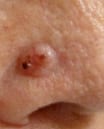
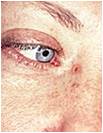
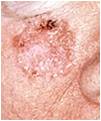
- What is it? Squamous cell carcinoma(SCC) is the second most common type. It starts in the epidermis, and, if left untreated, eventually penetrates the underlying tissue.
- Where does it occur? SCC is usually found on areas that are often exposed to UV rays. These include: face, neck, scalp, hands, shoulders, arms, and back.
- What does it look like? SCC can look like a wart-like growth that crusts and occasionally bleeds, a persistent red patch with irregular borders, an open sore that persists for weeks, an elevated growth or a growth that rapidly increases in size. SCC growths can also sometimes crusts or bleeds.
- Is it serious? It is easily treated when detected early, but, this cancer can spread to other parts of the body. If you suspect you have any of these symptoms, contact your doctor as soon as possible.
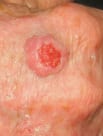
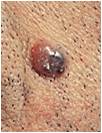
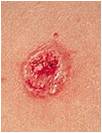
- What is it? Malignant melanoma is the most serious type of skin cancer and is responsible for the most deaths. Melanoma can develop from the same skin cells that create moles. [2]
- Where does it occur? Melanoma appears most commonly on the back and legs. However, it can appear anywhere on the skin surface or in the mouth or eyes. They can also be found in areas that don’t typically exposed to the sun.
- What does it look like? Melanoma can develop from a pre-existing mole that appears normal but then changes, or as a new irregular-looking spot on the skin. [2] Look out for irregular looking moles, or birthmarks with more than one color.
- Is it serious? Malignant melanoma is the deadliest form of skin cancer and causes more than 900 deaths every year. If you suspect you have any of these symptoms, contact your doctor immediately.
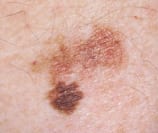
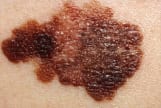
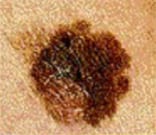
What are the risk factors for skin cancer?
About 90% of skin cancers are caused by UV rays, but there are other factors that can determine your risk. Some of these factors are:
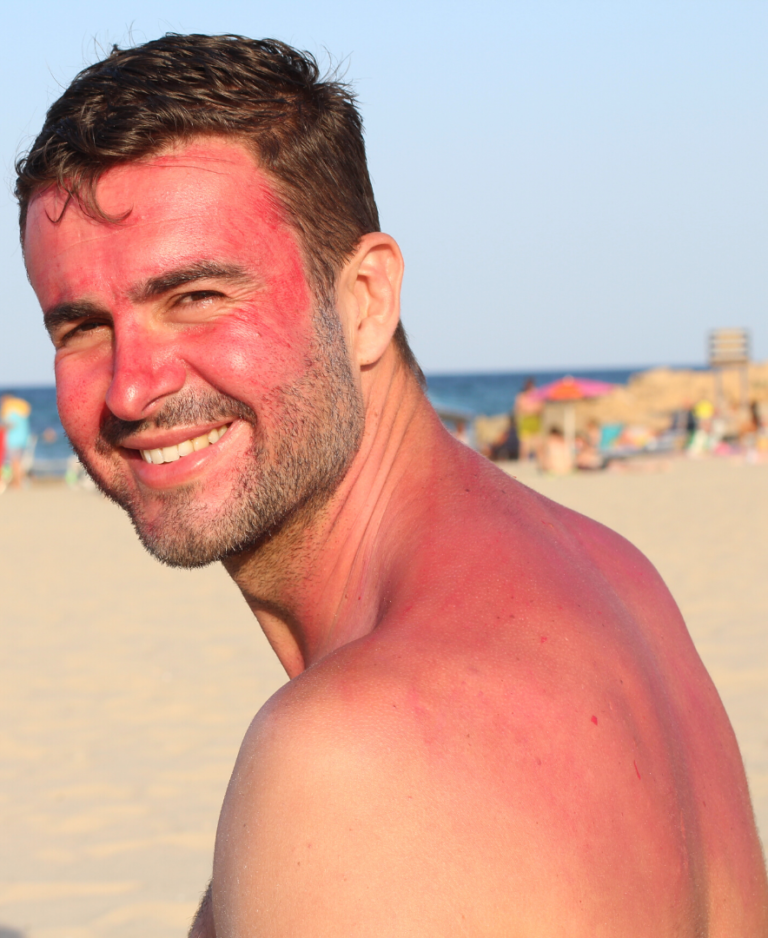
- Your complexion: Fair-skinned people have less melanin in their skin and therefore less protection against the sun’s damaging UV rays.
- Number of moles: The risk is greater for people with 50 or more moles.
- Tanning bed use: People are more likely to develop skin
cancer from using tanning beds than developing lung cancer from smoking. Their use causes a 75 percent increase in melanoma risk when indoor tanning beds have been used before age 30. - Family history: Having a family member with skin cancer means you are at greater risk. The risk is especially strong if a close relative, such as a parent, sibling, or child, has skin cancer.
- History of sunburn: People who have had one or more severe, blistering sunburns as a child or teenager have an increased risk for melanoma. Sunburns in adulthood are also a risk factor for melanoma.
- History of skin cancer: Once you’ve had one skin cancer, your risks for developing another increases.[2]
Ways to prevent skin cancer
Most cases of skin cancer are preventable. You can reduce your risk of getting skin cancer by following these safety tips:
- Cover up. When the UV Index is 3 or higher, protect your skin as much as possible. Wear light-coloured, long-sleeved shirts, pants, and a wide-brimmed hat made from breathable fabric. When you buy sunglasses, make sure they provide protection against both UVA and UVB rays.
- Limit your time in the sun. Keep out of the sun and heat between 11 a.m. and 3 p.m. The UV index in Canada can be 3 or higher during those times. When your shadow is shorter than you, the sun is very strong. Look for places with lots of shade, like a park with big trees, partial roofs, awnings, umbrellas or gazebo tents. Always take an umbrella to the beach.

- Use sunscreen. Put sunscreen on when the UV index is 3 or higher. Use sunscreen labelled “broad spectrum” and “water resistant” with an SPF of at least 30.
- Avoid using tanning equipment. There is no such thing as a ‘healthy’ tan. Using tanning equipment damages your skin and increases your risk of developing melanoma, the deadliest form of skin cancer.[3]
Other Skin Cancer Facts
- In 2016, about 6,800 Canadians were diagnosed with melanoma and 1,200 will die from it. Fortunately, early detection can improve treatment and survival. [3]
- One in every three cancers diagnosed worldwide is skin cancer, 80-90% of which are caused by ultraviolet (UV) radiation.
- Over 80,000 cases of skin cancer are diagnosed in Canada each year, more than 5,000 of these are melanoma, the deadliest form of skin cancer.
- When detected early, the 5-year survival rate for melanoma is 99 percent. [1]
- Canadians born in the 1990s have 2-3 times higher risk of getting skin cancer in their lifetimes (1 in 6 people) than those born in the 1960s (1 in 20).
- There are more new cases of skin cancer each year than the number of breast, prostate, lung and colon cancers COMBINED.
- Melanoma is the third most common form of cancer in Canadian women ages 15‐29. [6]

References
- Skin Cancer Facts & Statistics. (2019, March 11). Retrieved from https://www.skincancer.org/skin-cancer-information/skin-cancer-facts/
- Koskie, B. (n.d.). Skin Cancer: Facts, Statistics, and You. Retrieved from https://www.healthline.com/health/skin-cancer/facts-and-stats#18
- Public Health Agency of Canada. (2018, September 4). Skin cancer. Retrieved from https://www.canada.ca/en/public-health/services/sun-safety/skin-cancer.html
- Save Your Skin Foundation. (2019, December 5). Retrieved from https://saveyourskin.ca/
- The Alberta Society of Melanoma. (n.d.). Retrieved from https://abmelanoma.ca/
- https://www.partnershipagainstcancer.ca/news-events/news/article/working-to-halt-the-increase-of-skin-cancer-in-canada/
